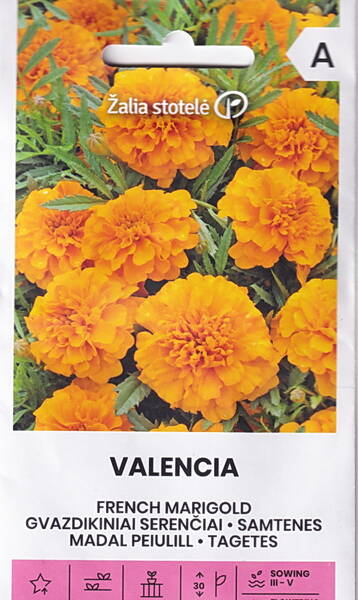Your shopping cart is empty!
Marigold "Valencia"
French marigold "Valencia" - Tagetes patula nana.
The earliest flowering!
Annual, height 30 cm.
Outstanding qualities are combined in marigolds: early flowering, compactness and an abundance of exceptionally double, large flowers of pure, richly bright colour. An unsurpassed plant for the garden and various containers!
Flowering: June - September.
Marigolds are unpretentious, fast-growing, light and heat-loving, drought-resistant plants. The optimum temperature for the growth of young plants is +18+20°C. At temperatures below +10°C, the leaves acquire an anthocyanin coating and growth stops. At -1-2°C plants die.
Location: do not need intense sunlight, although the maximum decorative effect is achieved in sunny places. This is especially true for thin-leaved marigolds. Poorly tolerate spring and autumn frosts.
Soil: require nutritious, well-moistened soils in the first half of summer.
Care: considered drought-resistant, but at the beginning of growth they need watering, otherwise, the plants will be puny and the inflorescences small.
Marigolds, especially erect marigolds, are negatively related to excess moisture in the soil. In rainy weather, their large inflorescences begin to rot. And if the soil is oversaturated with water, then the plants begin to die from fungal root diseases. Fertilizing in the spring will result in strong growth and delayed flowering.
1,0 g = 300-320 seeds.
The earliest flowering!
Annual, height 30 cm.
Outstanding qualities are combined in marigolds: early flowering, compactness and an abundance of exceptionally double, large flowers of pure, richly bright colour. An unsurpassed plant for the garden and various containers!
Flowering: June - September.
Marigolds are unpretentious, fast-growing, light and heat-loving, drought-resistant plants. The optimum temperature for the growth of young plants is +18+20°C. At temperatures below +10°C, the leaves acquire an anthocyanin coating and growth stops. At -1-2°C plants die.
Location: do not need intense sunlight, although the maximum decorative effect is achieved in sunny places. This is especially true for thin-leaved marigolds. Poorly tolerate spring and autumn frosts.
Soil: require nutritious, well-moistened soils in the first half of summer.
Care: considered drought-resistant, but at the beginning of growth they need watering, otherwise, the plants will be puny and the inflorescences small.
Marigolds, especially erect marigolds, are negatively related to excess moisture in the soil. In rainy weather, their large inflorescences begin to rot. And if the soil is oversaturated with water, then the plants begin to die from fungal root diseases. Fertilizing in the spring will result in strong growth and delayed flowering.
1,0 g = 300-320 seeds.
Eng.: French marigold. Bot. syn.: Tagetes corymbosa Sweet, Tagetes remotiflora Kunze, Tagetes signata Bartling.












